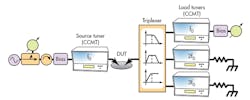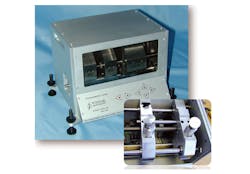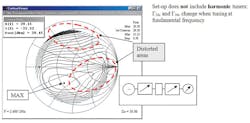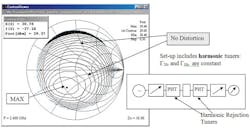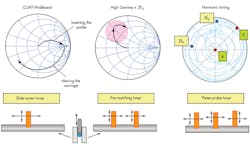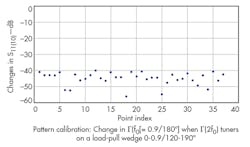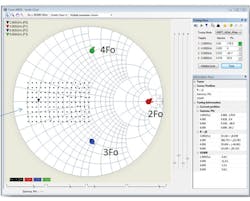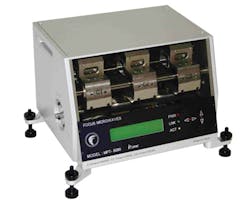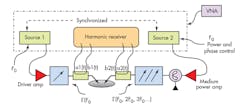The Evolution of Harmonic Load Pull
Download this article in .PDF format
Load-pull tuning has long been a vital tool in analyzing and characterizing active devices, such as RF/microwave power transistors, to changes in the source and load impedances presented to the device. Typically, load-pull tuners change the impedances to the active device while additional measurement equipment—like a vector network analyzer (VNA)—is used to measure device characteristics, such as amplitude, phase, and scattering (S) parameters.
By tuning the impedances during measurements, the optimum source and load impedances to the device under test (DUT) can be found for the creation of impedance-matching circuitry. This enables transitions from the device impedances to the characteristic impedance (typically 50 Ω) of the circuit or system in which the active device will be used.
Over the years, load-pull technology has evolved from its humble beginnings to more elaborate and sophisticated tools and techniques. Many load-pull tuners developed with broadband capabilities and intended for creating controlled impedances at fundamental frequencies, or F0, have also created uncontrolled impedances at harmonic frequencies of the fundamental, such as 2F0, 3F0, and so on. Most engineers working with load-pull testing have worked with such an uncontrolled harmonic test environment for at least a 15-year period.
Efforts to control this test environment led to the development of harmonic load-pull solutions, using a fundamental-frequency test tone and one or more harmonic frequencies of that fundamental frequency. The use of harmonic load-pull testing has often helped to increase the power-added efficiency (PAE) of an amplifier or active device, or else reduce the error vector magnitude (EVM) of a power amplifier being operated in backed-off bias conditions.
Early attempts to develop harmonic load-pull tuners typically inserted narrowband frequency discriminators, such as diplexers or triplexers, between a DUT and a wideband impedance tuner (Fig. 1). While such an approach can provide some control over the harmonic frequencies, it is typically limited in its power range and bandwidth and susceptible to spurious signal products.1
By 1998, a simple solution had been proposed for load-pull harmonic tuning,2 which was “productized” in the form of the Programmable Harmonic Rejection Tuner (PHT) from Focus Microwaves in 2000. Figure 2 shows a load-pull setup using a harmonic-rejection tuner on the output of the DUT.
These harmonic tuners are inserted between a wideband tuner and the DUT. They use a set of remote-controlled open-stub quarter-wavelength resonators at the first- and second-harmonic frequencies (2F0 and 3F0). They slide on top of the center conductor of the airline used for the wideband load-pull tuner and can be tuned back and forth with little ill effect on the fundamental-frequency impedance, Γ(F0).
The approach used in the PHT system can provide full 360-deg. phase control at high values of Γ on the order of 0.98, critical for optimizing the PAE of a power amplifier. The PHT systems have two important characteristics: their resonators reflect all harmonic power back to the DUT so that the wideband load-pull tuner acts as a pure fundamental-frequency tuner, and they are 50-Ω-matched at low frequencies to minimize spurious oscillations.
Figure 3 shows a PHT and its internal mechanism for changing resonators.
Figure 4 depicts load-pull contours from a wideband tuner (the deformation due to uncontrolled harmonic impedance can be seen). Figure 5 shows load-pull contours measured after a PHT has been inserted to maintain constant harmonic impedances.
The PHT systems enabled analysis of high-Γ load-pull contours for many PHT users, providing data under controlled-impedance test environments.2,3 Still, these systems suffered frequency-band limitations and the amplitude of Γ could not be controlled, leading many customers to desire more wideband tuning and full control of Γ at harmonic frequencies.
For versatility, the Multi-Purpose Tuner (MPT) was introduced in 2004 (United States patent No. 7,135,941), with the first units appearing on the commercial market in 2006. The MPT is essentially a cascade of three wideband, single-probe tuners, all covering the same bandwidth and contained within a single instrument housing. The number of probes determines the possible tuner settings (Fig. 6).
In the case of two cascaded probes, a few million different tuner settings are possible, allowing high-gamma tuning and two-harmonic-frequency tuning. With three cascaded probes, billions of possible probe combinations are possible, allowing fundamental-frequency [Γ(F0)] and as many as three harmonic reflection factors [Γ(2F0), Γ(3F0)] to be synthesized simultaneously and independently.
The MPT concept apparently works for all frequencies and impedances within a given tuning range and within the common frequency bandwidths of all probes. A two-probe impedance tuner can cover the entire Smith chart for two frequencies, and can also tune three frequencies independently, but it cannot do so over the entire Smith chart. There are areas of the Smith chart, inside the |Γ| range of the probes, which harmonic tuning simply cannot reach.
Given the limitations of the two-probe load-pull systems, integrating three probes within a single load-pull system housing (using the same airline) made sense as part of the evolution of load-pull technology. Such as approach, implemented in three-probe MPT systems, eliminates adapter loss and residual reflections associated with assemblies of three cascaded wideband tuners.
A system with the three integrated probes must be calibrated within a limited period of time, and developing such a system requires the development of efficient tuning algorithms using the calibration data. Unfortunately, calibrating each of the billions of possible probe positions could possibly take years. Part of patent No. 7,135,941 is a calibration method. It involves de-embedding of the initialized impedance tuner—a concept not immediately obvious, and one which enables calibrations of MPT systems in just minutes.
The second challenge in designing an effective three-probe harmonic load-pull system (efficient tuning and high harmonic isolation) required several years of development and many engineering iterations, as is often the case for original designs (patent Nos. 8,629,742, 13/915,160, and 12,929,643, pending). Admittedly, the first harmonic load-pull tuning operation in 2004 with a three-probe MPT system took more than 30 min, a task which today requires barely more than two seconds.
Achieving high tuning accuracy and high harmonic tuning accuracy can be extremely difficult for a system housing a cascade of three independent, highly reflective probes and the same airline. But after almost 10 years of work on this three-probe concept at Focus, the MPT system approach provides excellent tuning accuracy of typically 50 dB or more and similar harmonic tuning isolation (Fig. 7).
Gaining these excellent performance levels required ongoing improvements in software algorithms and mechanical precision. While a single-probe tuner may have possibly 10 problems or issues for a developer, a three-probe MPT system with its greater complexity can present as many as 1000 issues to overcome.
The validity of a four-probe harmonic load-pull tuning approach was explored by designing a tuner named “Quattro” for operation from 1.8 to 10.0 GHz. It is capable of independently tuning across frequencies from the fundamental, F0, to the fourth harmonic at 4F0. In measurements made with this four-probe tuner, all points of a load-pull pattern at a particular fundamental frequency, F0—such as the 2 GHz in Fig. 8 (the black dots)—can be tuned while Γ(2F0) to Γ( 4F0) remain fixed (the colored dots in Fig. 8).
Active Tuning
The use of active tuning offers several potential benefits in the evolution of load-pull tuners (e.g., overcoming the fixture insertion loss limiting passive load-pull tuners). One definition of active device tuning refers to injecting into the output of a transistor a signal which is coherent or synchronized with the input signal and can be controlled in terms of amplitude and phase, to evaluate a virtual or active load. For the transistor, this would be as if the signal was reflected by a passive tuner. In addition to the loss compensation leading to the fact that |Γ| = 1 can be reached, the active tuning approach can be implemented with standard commercial components, bypassing the mechanical precision required for fabricating passive electromechanical impedance tuners.
Active load-pull tuners can be designed as closed-loop or open-loop systems. In closed-loop active load-pull systems, the outgoing signal is sampled, amplified, phase modulated, and re-injected into the transistor output. Technical details on such tuner approaches have been published since the mid-1980s, with a commercial product, the Active Load Pull System (ALPS), introduced by Focus in 1998.7 But because of spurious signal issues and other side effects, these active load-pull systems did not make any type of penetration into the RF/microwave market.
Open-loop active load-pull systems, where a second synchronized signal is injected into the transistor output, avoid many of the problems associated with closed-loop load-pull systems, such as spurious oscillations. However, a shortcoming of the open-loop approach is the need for high RF/microwave power of the output-injected signal source or power amplifier, to overcome the impedance mismatch between the low impedance of many power transistors (about 1 Ω in the setup and the internal impedance of the injecting signal source (50 Ω).
At very high-Γ values, the required injection power can reach 20 times the output power of the transistor under test. This simply may not be possible or financially affordable. This high power requirement can be relieved by using an impedance transformer (pre-matching tuner) between the transistor and the load—i.e., configuring a “hybrid” or “active-passive” tuning system. This reduces the need to inject power roughly by a factor of 10. In a hybrid system, the injection power requirement is reduced to less than two times the transistor output power.
As far as the tuning speed limitations of mechanical load-pull tuners, a hybrid load-pull system can be configured with the mechanical tuner placed permanently in a position optimized for overall reduced injection power. All remaining tuning is then performed electronically and quite quickly, depending essentially on the response time of the receiver (load-pull patterns including 50 points have been measured in roughly 1.5 s or 35 ms/point with this hybrid load-pull tuner approach).
This hybrid solution is promoted as the hybrid active injection load pull (HAILP) technique. It is covered by patent No. 8,497,689; as well as pending applications 61/914,035 and 62/042,550.
If an MPT system (Fig. 9) incorporates the HAILP technique, independent passive harmonic load-pull tuning can be overlapped with the active harmonic load-pull tuning capability of the MPT system.
In such a hybrid version of an MPT system (Fig. 10), the optimum Γ value is higher than a passive system, (close to |Γ| = 1), and the maximum output power of the hybrid system is almost 5 dB higher than the passive version.
The hybrid system offers an additional benefit for verifying the overall system accuracy: At the same values of passive (pre-calibrated) impedance and active impedance, the system must generate the same output power and gain. This can easily be done by switching between purely passive and purely active tuning to the same load impedance. Having higher Γ values lead to higher PAE performance in a DUT and a higher PAE swing.
Harmonic load-pull tuning has progressed a great deal since the introduction of automatic impedance tuners in 1985. Innovations have enabled progress, but some good ideas may not always be practical, depending upon available technology. For example, the MPT tuning algorithms now used would not have been possible in 1998 when the PHT was introduced: the necessary computing power for those algorithms simply was not affordable for the majority of working engineers in 1998.
Not all ideas can be turned into practical solutions, but the innovations from those working in the industry on load-pull systems may hopefully continue to surprise and serve those who can benefit from those systems.14,15
Dr. Ing. Christos Tsironis, President
Focus Microwaves, Inc., 1603 St. Regis, Dollard-des-Ormeaux, Quebec H9B 3H7, Canada; (514) 683-4554, FAX: (514) 684-8581
References
1. Maury Microwave, “Device characterization with harmonic source and load pull,” Application note 5C-044, (December 2000).2. C. Tsironis, “Harmonic Rejection Load Tuner,” United States Patent No. 6,297,649 (1998).
3. C. Tsironis and N. Misljenovic, “Pitfalls to Avoid When Using Load-pull Contours for PA Design,” Microwave Journal, March 2004.
4. C. Tsironis, “Triple Probe Automatic Slide Screw Load Pull Tuner and Method,” United States Patent No. 7,135,941 (YEAR).
5. C. Tsironis, “Calibration and Tuning Using Compact Multi-Frequency Range Impedance Tuners,” United States Patent No. 13/851,607 (to be issued).
6. C. Tsironis, “Harmonic Impedance Tuner with Four Wideband Probes and Method,” United States Patent No. 8,405,475 (YEAR).
7. J. Browne, “System Performs Active Load Pull Measurements,” Microwaves & RF, November 1995, pp. 102-108.
8. ATN Microwave, Inc., “A Load Pull System with Harmonic Tuning,” Microwave Journal, March 1996, pp 128-132.
9. Ferrero, “Active load or source impedance synthesis apparatus for measurement test set of microwave components and systems,” United States patent No. 6,509,743.
10. Tasker, et al. “Methods and apparatus for time-domain measurement with a high frequency circuit analyzer,” United States Patent No. 6,639,393.
11. C. Tsironis, “Method for Reducing Power Requirements in Active Load Pull Systems,” United States Patent No. 8,497,689 (YEAR).
12. C. Tsironis, “Hybrid Split Signal Load Pull System,” United States Provisional Application No. 61/914,035 (2014).
13. C. Tsironis, “High Speed Hybrid Active Load Pull,” United States Provisional Application No. 62/042,550 (2014).
14. C. Tsironis, “Compact Impedance Tuner,” United States Provisional Application No. 62/017,930 (2014).
15. C. Tsironis, “Compact Two Probe Impedance Tuner,” United States Provisional Application No. 62/034,201.

